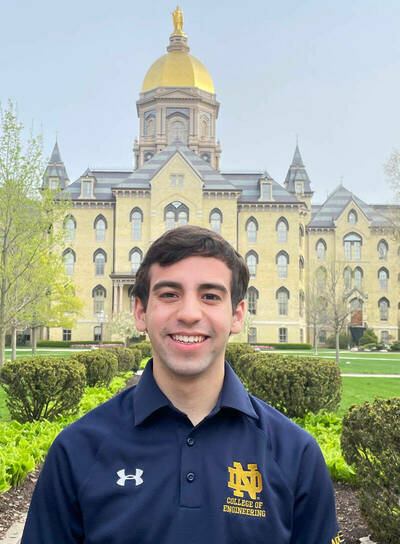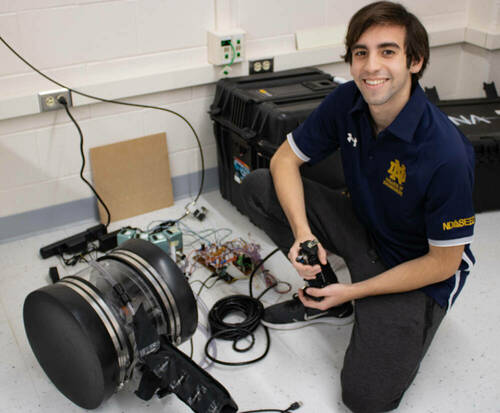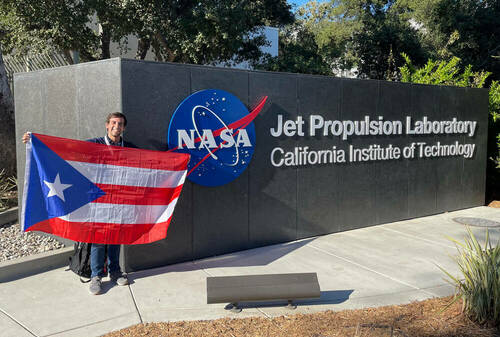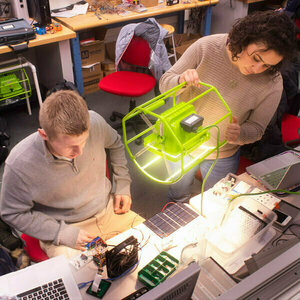
Nelson Badillo ’23 was 17 years-old when Hurricane Maria hit his home island of Puerto Rico. The category 5 hurricane is considered one of the worst natural disasters in recent history to take place in the northeastern Caribbean. The storm decimated many parts of Puerto Rico, including Moca, the city where Badillo and his family lived.
“Hurricane Maria destroyed my entire community. I and everyone around me were cut off from the world,” says Badillo. For three months, the community had no power and no access to fresh food and running water. There was no school either.
“It just put a pause on everything and it was really hard,” says Badillo. Perhaps most heartbreaking were the reports that came via radio, the only available method of communication for people in his community.
“When you turned the radio on, people were calling, looking for their missing relatives, people who were trapped below the rubble of mudslides, people who were taken away by the current of a river during the hurricane…And that’s the only thing I would hear for days,” says Badillo.
Badillo was deeply affected by the suffering of the people around him as they struggled to recover from Hurricane Maria. Shocked and heartbroken, he says he started thinking, “There has to be something I can do.” This desire to help, paired with his love of robotics, drove him toward an idea for a design that could make a difference.
Badillo has always loved robotics and he knew he wanted to study engineering-related subjects from a young age. “Since I was five years-old, I just loved to tinker around with building blocks. And that just sort of progressed into a curiosity toward mechanical systems and specifically robots,” he explains.
When Badillo was around 11-years-old, his fascination with robots led him to help bring robotics education to his area. Coming from a rural town and a community where there was a dearth of education in engineering, “that really pushed me and my parents to find resources and get something in robotics started,” he says.
He and his family approached the Puerto Rican Institute of Robotics, a nonprofit educational organization based in San Juan. Staff there told Badillo that if he drummed up enough interest, the organization would come to [Moca] and offer robotics courses. Badillo talked to the people in his community, including kids and their parents, and even the school director, and managed to find around 12 students who were interested.
“That was amazing,” says Badillo. He had found a way to pursue an education in robotics along with his community.
The experience fueled his passion and Badillo continued to learn, taking courses and entering robotics competitions through high school.
After Hurricane Maria and experiencing its devastation, Badillo became even more certain that robotics was his path.
“When Hurricane Maria hit, I began drawing and designing plans, making prototypes,” says Badillo, and through his ideating he came up with a concept. He wanted to create a robot that could enter into dangerous places, like buildings turned to rubble by natural disasters, and locate survivors.

“But I didn’t have any resources,” he says. To really develop his idea for this type of robot, Badillo needed to put himself in a position to create and test it. That’s when he began looking at schools in the United States, places with engineering education, where he could find both the knowledge and resources he needed to make his dream a reality.
A personal connection led him to Notre Dame. While applying to schools in the U.S., Badillo sought counsel from a local foundation that helps low-income students from Puerto Rico with the process of applying to schools in the mainland. The Kinesis Foundation was formed and is headed by Notre Dame alumnus José Enrique Fernández ’65. Fernández mentored Badillo.
“He took me under his wing,” says Badillo, and when Badillo told Fernández what he wanted to do with his education, Fernández said that, given its excellent engineering school and mission as a force for good in the world, Notre Dame would be the perfect place for Badillo.
Now, as a mechanical engineering major at Notre Dame, with a concentration in automated systems and controls, Badillo has had the opportunity to further develop his ideas.
“Since coming to campus, I've had the opportunity to develop my passions in robotics through my courses. I've been able to explore all versions of mechanical engineering and really get the knowledge I need to develop my ideas in robotics,” says Badillo.
He has supplemented his coursework with research both on and off campus.
During his first year, Badillo worked on a project with the Kaneb Center for Teaching Excellence, researching engineering education. He then pursued a yearlong fellowship with the Institute for Advanced Studies focusing on patent law and computer science.
Beyond campus, he was admitted to the Wave Research Fellows program at the California Institute of Technology, where he conducted research in the Aerospace, Robotics, and Controls Laboratory. And last summer, Badillo was a research fellow with NASA’s Jet Propulsion Laboratory, where he worked with the Extreme Environment and Robotics Group on developing a new robot for a mission to Venus called the Variable Altitude Aero Bot.

Along with his other research, Badillo has maintained his work on the idea for a disaster relief robot. He has been working closely with Assistant Professor of Aerospace and Mechanical Engineering Margaret Coad in the Innovative Robotics and Interactive Systems (IRIS) Lab, working on the world's first self-propelled toroidal robot, which, Badillo explains, is a soft robot that can go into confined spaces like collapsed homes, pipes, and can locate survivors.
The robot has potential applications in disaster relief and also healthcare, where, due to its ability to compress in size, it could potentially be used for patient endoscopies.
Coad and Badillo have published a paper on the robot and will present their research at the International Conference on Intelligent Robots and Systems in Japan later this year.
His Notre Dame research experience has been “amazing,” says Badillo. “I've been able to apply everything that I've learned in my classes and really put it into a project that I'm really passionate about that can potentially help save people.”
Badillo will continue on his robotics path and intends to pursue a Ph.D, after graduating from Notre Dame next May. He plans to one day return to Puerto Rico permanently where his dream is to establish a robotics company that focuses on robots for both disaster response and space exploration.
“[I want to] develop the innovative environment in Puerto Rico and help provide other people who are passionate about robotics, like myself, with an opportunity to stay in Puerto Rico and develop these ideas that could help save lives there,” he says.
Meanwhile, Badillo is appreciating his last year at Notre Dame and the support that has helped him to get this far in bringing his ideas to fruition.
“Since day one, Notre Dame has supported me in every way,” says Badillo. “They have provided me with generous financial aid to allow me to study in a place like this. And the professors here have given me the faith and support to help me develop into someone that can contribute to the field of robotics. And that’s cool. That’s why I love Notre Dame so much.”
